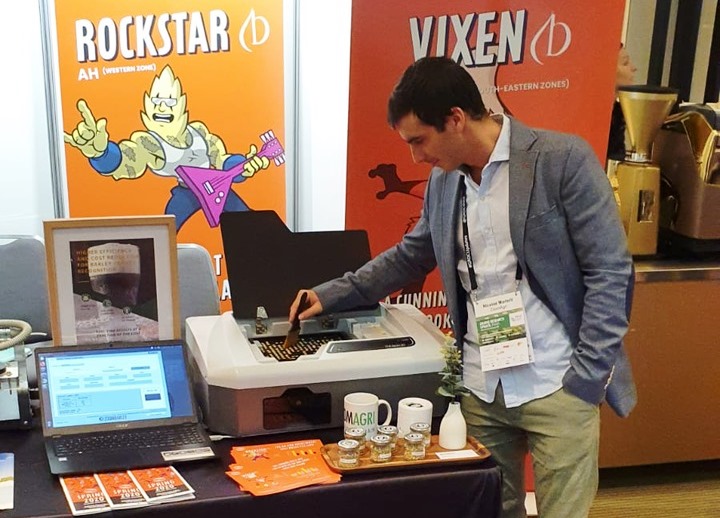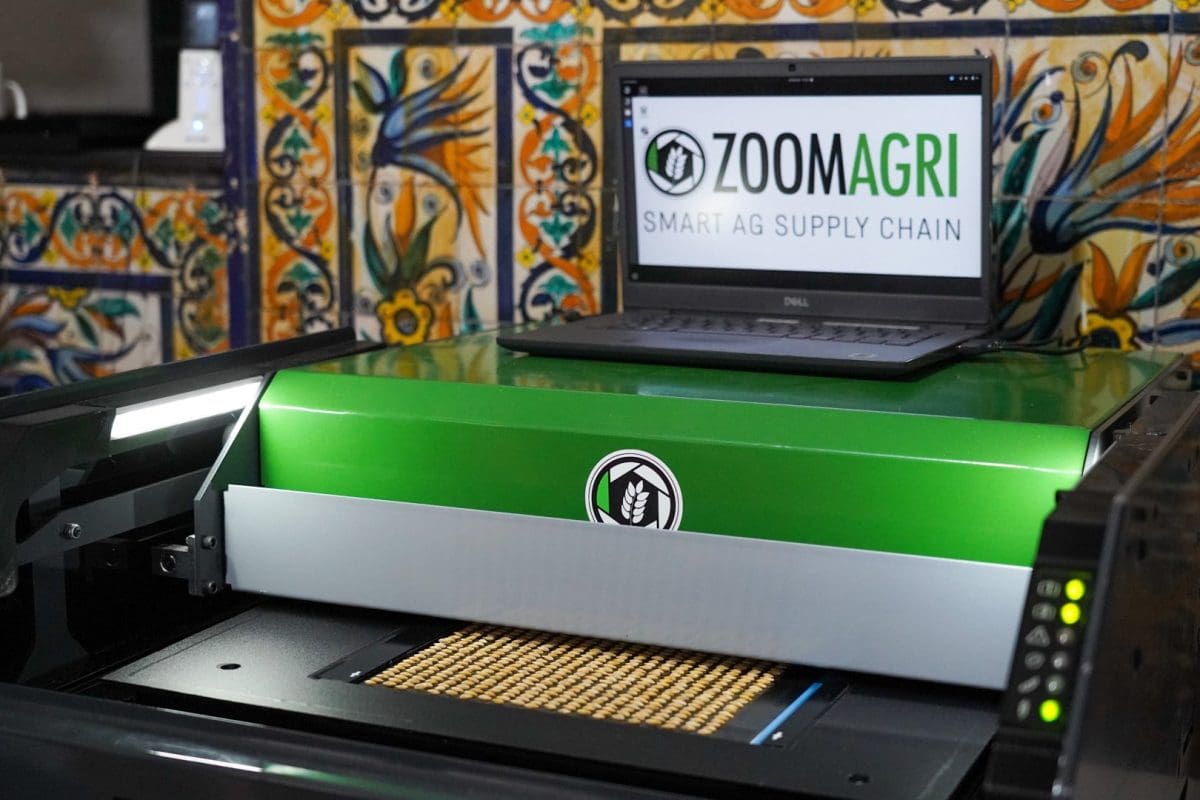
Nicolás Martelli with a ZoomAgri unit at the 2022 GRDC Update in Perth. Photo: InterGrain
GLOBAL agtech company ZoomAgri has brought machine learning to what is arguably the most quality-conscious bulk commodity market of them all: malting barley.
Outside Australia, ZoomAgri technology is used with wheat, corn and soybeans, and its ZoomBarley machines and software are in use in the Americas and Europe, as well as South Africa, and South and Central Asia.
Originally badged ZoomBarley, ZoomAgriOne units in Australia are deployed at two malthouses: Coopers in Adelaide and Malteurop in Geelong.
ZoomAgri’s partnership with Australian seed company InterGrain means its units are also in use at the company’s head office in Perth, and also at its facility in Horsham in Victoria.
They are also being road-tested by two eastern-states bulk handlers, and are being trialled in countries including Australia to detect sieving and quality defects in barley.
In conjunction with wheat breeders, ZoomAgriOne is under development to provide varietal recognition of wheat so end-point royalties (EPR) can be paid at correct rates to their owners.
Certainty for EPRs
ZoomAgri was founded in Argentina in 2017, and is headquartered in Argentina.
Its other offices are located in Brazil, Spain and Australia.
ZoomAgri’s Australian office was opened in Perth in 2019 by business development manager Nicolás Martelli following the establishment of a relationship between InterGrain and ZoomAgri.
“ZoomAgri started because the founders thought the way we did commodity assessment was very out of date and there should be a better way; that’s when they came into the AI space.”
At the heart of each ZoomAgriOne machine is technology which generates images at around ten times the resolution of an iPhone camera.

The ZoomAgriSpex machine can detect a number of defects in grain. Photo: ZoomAgri
Coupled with algorithms built from images of around 200 million kernels, Mr Martelli said it gives ZoomAgriOne the ability to accurately distinguish varieties within minutes.
“The human eye can narrow a sample down to a couple of varieties by looking at characteristics like the colour, shape, hair, and wrinkle on a grain of barley; ZoomBarley can narrow it down to one.”
With varieties often having parents or close relatives in the supply chain, Mr Martelli said being able to identify the variety beyond doubt was a value proposition for breeders, growers, maltsters, marketers and bulk handlers.
“Whatever environment it is grown in, we can be sure of the variety, whether it’s grown in Geraldton or Horsham or Toowoomba.”
Aside from widespread interest and support from the malting industry, Mr Martelli said the end-point royalty scheme, which ideally returns to the breeder a variety-specific fee for every tonne of commercial grain sold, has enhanced the appeal of ZoomAgri.
“The EPR system in Australia is very different to what exists in other countries, and it has made varietal identification here in Australia something of interest for the breeder.”
“I came here in 2019 with only the barley product because ZoomAgri partnered with InterGrain for that reason.”
Metrics for maltsters
ZoomAgriOne is used by a several maltsters with global operations, including AB InBev, Boortmalt, Malteurop, and Soufflet.
“Maltsters are the most interested in varietal purity so they can be sure they are malting the barley in the best possible way.”
Coopers is Australia’s largest independent brewer, and the family-owned business each year takes in around 85,000t of barley at its sole malthouse.
It has been using a leased ZoomAgri unit for two years.
Coopers maltings manager Doug Stewart said the unit is used at the Adelaide facility to make for additional peace of mind in the malting process, and ensure the correct funds go back to the breeders through EPRs.
“There’s an operational perspective, and that’s for us to know we have the right grain in our malting process,” Dr Stewart said.
“We’re also making sure EPRs go to the right place; breeders have done the right thing by bringing us high-quality varieties, and they deserve to be paid properly for it.”

Dr Doug Stewart. Photo: Coopers
In addition to the ZoomBarley unit, Coopers is trialling a ZoomAgriSpex unit which can detect barley defects such as insect damage, broken grain, skinning, dark tip, sprouting and field fungi, all related to colour, size and shape.
Dr Stewart said the defects unit had the potential to help streamline the suite of tests Coopers staff conduct on each load of barley coming into the plant to determine specs like protein, moisture and dormancy period, plus tests that have traditionally relied on visuals.
Ahead of accepted loads tipping, Dr Stewart said the entire testing process takes around 15-20 minutes, and use of Zoom’s quality assessment can potentially shave a few minutes off the exercise.
“If part of that testing can be automated, it can take a bit of the pressure off everyone.”
“Using Zoom makes it objective, and operationally, it could free up our guys in those really busy periods by getting trucks tipping faster.”
Grower samples invited
InterGrain is jointly owned by the Grains Research and Development Corporation, and by the Western Australian Government.
Through its partnership with ZoomAgri, InterGrain is inviting growers to submit up to three samples for testing free of charge at its Horsham and Perth facilities.
EPR compliance, namely the misdeclaration of grain at point of sale which sees seed companies underpaid for their highest-value varieties, is arguably the Achilles heel of the EPR system.
InterGrain chief executive officer Tress Walmsley said the company manages its EPR compliance through a range of activities, and ZoomAgri offered an additional one.
“We saw that this variety identification was a positive technology as it has the potential to offer benefits to breeding companies, growers and end-users of our varieties,” Ms Walmsley said.
“We utilise the technology within our business. Our breeding samples are regularly tested to develop and improve the tool.
Ms Walmsley said InterGrain has been promoting the tool to a range of potential users, including grain traders.
“We always like to take a collaborative approach and we are very open to working with all industry players.”
Along with bulk handlers, InterGrain is working with ZoomAgri to develop a ZoomAgriOne variant for wheat as well as barley, but a launch date for the wheat product is yet to be set.
“The technology is in the fine-tuning phase and growers are welcome to send in wheat samples to assist in developing the algorithm, although results will not be 100 percent accurate until the product is launched.”
ON MONDAY: Read about GoMicro
The first story in our Grain AI series can be found here.
Grain Central: Get our free news straight to your inbox – Click here


HAVE YOUR SAY